Michael A. Turton
|
Michael A. Turton |
|
|
|
|
|
|
|
| Taiwan, and Taipei in particular, has excellent Chinese food, of course. Cuisines from every part of China are represented in the major cities and there are restaurants to suit any pocketbook |
| Like all cultures, the Chinese borrow freely from
abroad
and fusion dishes which utilize non-Chinese ingredients such as cheese,
ketchup or mayo are common in larger restaurants. There are also a
plenty of weird restaurants, like this toilet bowl-themed
place a friend of mine alerted me to. |
|
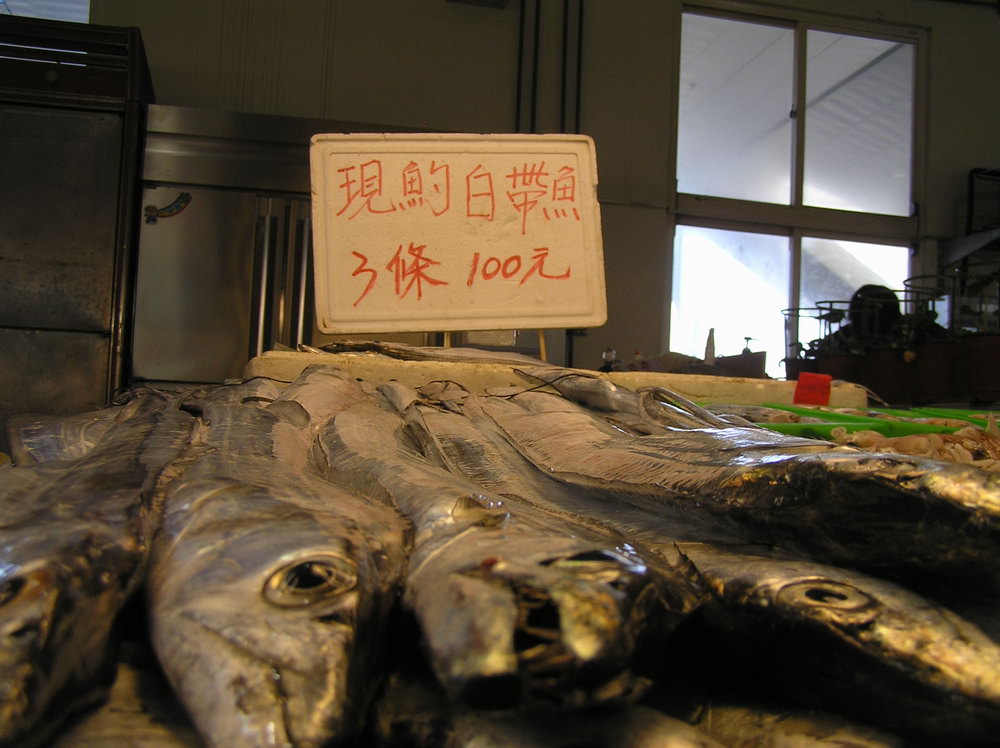 Fish for sale in a local fish market. |
|
| There are so many wonderful places to eat that I couldn't even begin to list them all. Many places advertise in the local English paper. In addition to individual eateries, there are also specialized streets for certain types of food, such as the beef noodle street in the railroad company compound just north of the main Post Office in Taipei, whose establishments offer up some of the best beef noodle on the island. |
| Your friends will be able to tell you which restaurants are good locally, but a sure sign is a place that is packed at meal times. |
| It used to be that there was a lack of foreign
foods
and foreign
restaurants, especially outside of Taipei, but this has changed.
Western style restaurants are everywhere, though naturally their
cuisines are modified to suit local taste buds.
|
| As Taiwan slowly and painfully globalizes, more and more foreign food places are appearing. |
|
|
|
|
|
| Mass food poisonings happen from time to time and large international hotels are sometimes busted for unsanitary conditions. Since payoffs are a way of life in the food trade, there is little regulation of the industry. |
| On the other hand, the average vendor or family-owned restaurant prepares the food right in your view. You can pick side dishes yourself and are served on disposable plates with wooden chopsticks. Food is boiled constantly and the risk of food poisoning is lower. The food is usually better too. |
| Do not buy processed foods like flavored tofu, preserved fruits, and so forth in the local market where they are kept in large bins in the open. The preparation and storage of such items are frequently not in compliance with health regulations. Instead, buy pre-packaged foods in your local supermarket from recognized national brands. |
 Fried/steamed buns sold in a Taipei shop. |
For vegetarians Taiwan poses
no problems. |
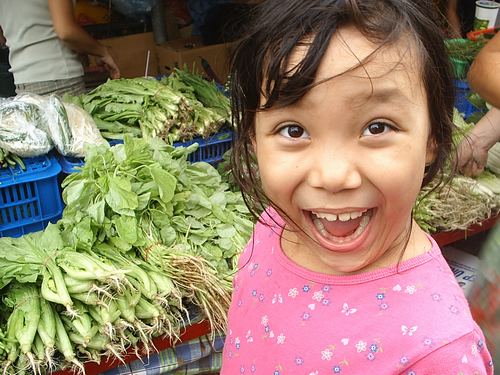 My
daughter marvels at the selection of vegetables.
My
daughter marvels at the selection of vegetables. |
There are two distinct types of vegetarian cuisines available. One is just vegetables, tofu, and so forth, what we would think of as vegetarian cuisine in the West. The other, however, is an invention of Buddhist chefs and uses vegetable materials to imitate the flavor and texture of meat, with superb results. |
| Many Taiwanese are vegetarians and vegetarian cuisine is widely available in the cities (our perfectly ordinary middle-class neighborhood in Taipei had two veg restaurants). When you work you can always get the standard lunchbox meal, the famous bien dang, in a vegetarian version. No one considers vegetarianism unusual or even worth remarking on. |
| One problem: in ordinary
restaurants
vegetables, especially greens, may be served sweetened with pork fat
or with ground fatty pork. Just because it's a vegetable, doesn't mean
it's vegetarian.
Thus, if you order greens, make sure you get them without anything on top. |
| Additionally, many breakfast places fry their stuff in lard for its superior flavor and crispiness. You can check this by looking at the oil as they pour it into their frying pans. If it is whitish, it is probably lard. | |
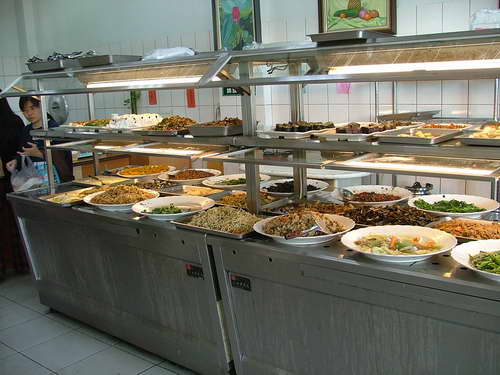 The riches of a small vegetarian buffet
restaurant in Taichung. The riches of a small vegetarian buffet
restaurant in Taichung. |
If your school sends out for lunches or dinners for you, they are typically happy to order a vegetarian meal if you tell them you prefer that. |
| Milk is expensive here. A common problem is that much of the "milk" sold in Taiwan is actually reconstituted from powder, especially in smaller groceries and markets. If you are a milk person, purchase name brands from 7-11 or larger, more modern supermarkets. |
| And beware: several brands (including the 7-11 house brand, President), cut their 2% milk with sugar to make up for the lack of sweetness due to the reduced fat. Local yogurts also tend to be made from reconstituted milk powder. |
| The delicious, ubiquitous Pearl Milk Tea is generally made with powdered tea and "milk" -- the milk being vegetable oil creamer rather than a diary product. If you are picky, be sure that your Milk Tea comes from a vendor who uses real milk (there are many). | 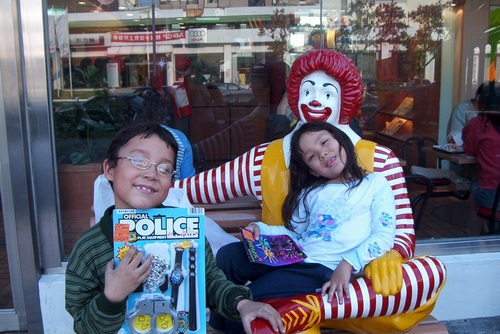 There's more fried chicken at McDonald's in Taiwan, and no
quarter-pounders. There's more fried chicken at McDonald's in Taiwan, and no
quarter-pounders. |
| Common rip-off: some vendors will deliberately attempt to give you the smallest piece of whatever they are buying, especially if you are a regular customer. The best stuff is reserved for new customers. The logic is, if you're a regular, you've been captured, so why should they bother to give you the good stuff? |
| For example, I used to be a regular customer of a certain lunch vendor who sold pork chop rice, a common lunch. If the owner served me, I got a whole pork chop plus a chunk of another one. If the wife served me, she rooted through the stack to find the smallest pork chop, and gave me that. I have had this experience at vendors all over the island. <sigh> |
| Preparing food at home is often more expensive than eating out cheap. This is because supermarkets are not allowed to sell at wholesale prices, competition is regulated by informal agreements among retailers (for example, department stores alternate sales so they don't compete against each other) and various other factors (organized crime, high demand, etc). |
| Food prices can be
staggering in
the supermarkets and traditional markets in some areas (prices also
vary
widely across major cities). Older sellers of veggies are often cheaper
than younger, since they maintain the prices of a vanished generation.
Here's a stroll
through
a traditional morning market.
To get good prices, it is best to become the established customer of a vendor. |
| I would avoid supermarkets entirely. Purchase at
either
local traditional markets or from volume retailers like Costco or RT
Mart. Prices
are
significantly higher at supermarkets. Moreover, expired foods are
often repackaged. In tradition markets, the food is right in front of
you, and its quality can be easily ascertained. Of course, shopping in
the traditional market is more fun too. |
| Cheating is common in the local markets, but most purchases will be OK. Cheer up! It's not just foreigners who get ripped off -- the Taiwanese cheerfully abuse each other as well. |
| One way to avoid market rip-offs is to pick the food out yourself. If you permit the vendor it pick it out, they might dump off rotten food on you. |
| Everything grown must be
washed
thoroughly. The growing organic movement here (stores in
every
neighborhood, prices in the stratosphere) bodes well for the future,
but
Taiwanese fruits and vegetables currently have extremely dangerous
amounts
of pesticides. |
| See my water page for details on the local water. |
| Thanks to additives in tofu, the brain cancer rate for vegetarians is ten times that of meat-eaters. Animals are pumped up full of antibiotics and drugs before being slaughtered and conditions are not exactly sanitary. In other words, whenever possible, buy imported foods. Also, ordinary salt often DOES NOT contain iodine. Be sure to buy iodized salt. It will say so in English on the label. |
| Many stands that sell pre-cut fruit prevent the fruit from oxidizing and make it appear whiter by dipping it in chlorine bleach. Be careful. |
| The "whole wheat" flour in Taiwan is
not whole wheat as we know it back home. Taiwan has no flour mills
capable of producing genuine whole wheat flour. Rather, the wheat is
processed into ordinary white flour and then the stuff that was removed
in the processing is mixed back in to make "whole wheat." Purchase
imported stuff at your local American grocery if you are picky. |
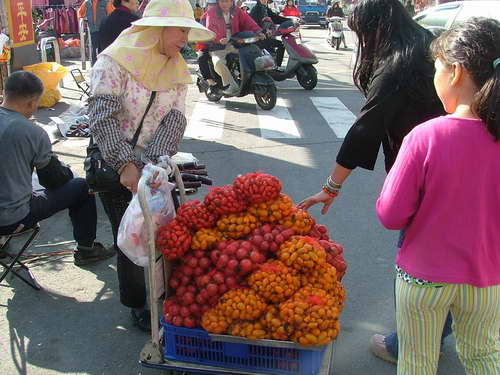 Buying tomatoes from a vendor in front of a local temple. |
| A problem that recently came to light is the use of reconstructed meat in local steak houses. Although the chains advertize that they sell steak, in fact meat sold in the cheaper steak houses is often processed, restructured using soy protein and food glues, and then pressed into the desired shape. |
|
|
|
|
|
| There is a tremendous variety of Western food available, especially now that the US retailer Costco has open outlets in Taipei and Kaohsiung. Additionally, western snack foods such as Nabisco and Frito-Lay offerings are available in all convenience stores. Some even sell mass-market picante sauces, although these are not popular, since the Taiwanese typically reject spicy foods. |
| In Taiwan, there are Italian restaurants in every city. Excellent Vietnamese and Thai food are available. Steak is a way of life in Taipei. Japanese restaurants may be found on every corner. Many small foreign eateries thrive around National Taiwan University catering to overseas Chinese and foreign students. Indian, Mexican, Morrocan and Arab places have opened in Taipei. In Kaohsiung, down by the docks, there are many excellent, cheap eateries that provide home cooking for the foreign sailers. |
| Of course, there is always fast food: McDonald's, Wendy's, Subway, Burger King, Sizzler, Ponderosa. Many foreigners find themselves eating at McDees far more often overseas than they do at home. |
| Outside of Taipei McDonalds, Subway, Dominoes and
Pizza
Hut will often be the only affordable western alternatives. Because of
the large numbers of foreign laborers from SE Asia and Indonesia, even
the smallest hamlets might sport Indonesian or Thai groceries, as well
as Thai
and Filipino cantinas serving great home-style food. |
Barbecue, popular the world over. |
Certain things are unobtainable except at high prices. Despite bakeries on every corner, decent bread (other than Wonder-style sponge crap) can be a pain to find, but now even medium-sized towns will offer quality bread somewhere in town. In recent years, bland, low-quality mass-market western cheeses have been making their way onto the shelves of even small local supermarkets. |
| A genuine coffee culture is springing up and specialty coffee shops are appearing in the larger cities. |
| The selection of fruits and vegetables has been improving in recent years as new products hit the market and restrictions on imports are relaxed. Large retailers will often have many different kinds of fruits available, and a much larger selection of greens and veggies than American supermarkets. |
| The
traditional
markets are filled with fruits and vegetables. Although limited by
seasonality, a large variety of things is available, expanded rapidly
in recent years. |
| Fortunately there is now a variety of foreign ice creams such as Haagen-Daz, Dove, and Dreyers. |
| As for local chocolates, you'd be better off
knawing the
melted ends of old scented candles. Luckily there is a plentiful supply
of medium-quality imported chocolate (Hershey, Dove, Cadbury, along
with some European and Japanese brands). Recently dark chocolate has
become popular, and it is now available in every convenience store on
the island. |
| Good wines are getting easier and easier to find, but they'll set you back apiece. Liquids labeled "wine" are widely sold in supermarkets and convenience stores. |
| Imported beer, including Corona, Heineken, and a variety of Asian brands, can be found in any convenience store. |
| Kitchens are nowhere near as well-equipped as incomes would seem to predict. The low quality of kitchens is hard to square with the importance of food in Taiwanese culture (but may have something to do with the overwhelmingly male architect population). |
| The oven situation was once grim. However, ovens are now sold everywhere. In Tienmu in Taipei there is housing catering to foreigners which has Western-style stove/ovens, and newer developments sometimes have western-style kitchens. |
| Cheap, large countertop ovens are now widely available, retailing for less than NT$2,000. |
| On the plus side, cooking is done with gas.
Nearly all
spices, herbs and baking materials are available, if not in your local
supermarket (which is often surprisingly well-stocked) than on Tihua
Street,
in Tienmu or at one of the supermarkets down by the universities. You
should
be able to find everything once you are familiar with the local area
and
nearby cities.
If you are a serious non-western ethnic cook, especially Indian or Mexican, I suggest bringing a large supply of difficult-to-find spices from home (ground coriander, fenugreek seeds, black mustard seeds) to tide you over until you can locate them somewhere in Taiwan. Italian or french cooks will have little trouble finding the things they need, though some ingredients will be pricey. Many ordinary Western spices are considered medicines in China and you can find such items as fennel and cinnamon at your neighborhood Chinese medicine store. Consult your dictionary. |
|
Trinity Food store, the Indian food grocery in Taipei, is located at: 2 / F, NO : 137, Chung Shiao East Road, Sec 5, Taipei,Taiwan. MRT station : Taipei City Hall MRT Station,Exit # 4, Two Minutes straight walking. TEL: + 886 2 27567992 , FAX :+ 886 2 27568042 |
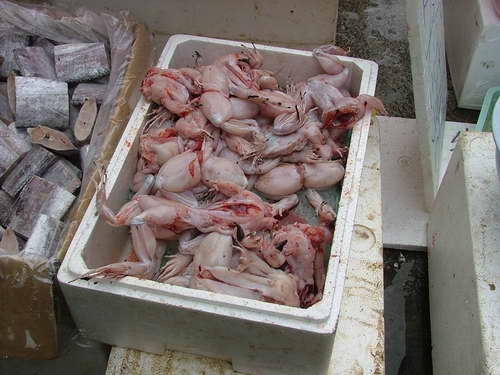 Frogs await culinary enthusiasts in a local market. |
| However, bulk spices are
widely available now. In Taipei Tihua Street, the spice and cloth
retailing street, has a plenitude of Western and Indian spices (my page on Tihua
Street). Many supermarkets will also carry a range of Thai foods,
and near industrial districts there are typically supermarkets catering
to workers from the Philippines, Thailand, and eslewhere. |
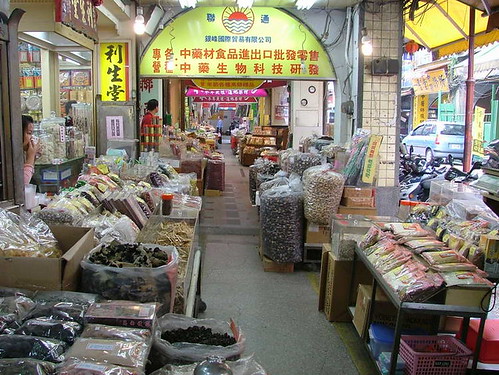 Spice shops on Tihua Street. |
|
|
|
|
|
| Taiwanese cooking is heavy on the fats and based on rice, fish and vegetables. Dairy products are not used, except where Western influence is heavy. |
| Only a few spices constitute the core of
Taiwanese cooking.
Local foods generally being sweetened with fats (the preferred
flavoring
is pork fat) and spiced with anise, soy sauce, salt, ginger and black
pepper.
Many dried or fermented objects, such as miniature shrimp and fish,
fermented
beans and dried plant parts, play the role of herbs and spices in other
cuisines. Large amounts of oil are preferred. Heat is supplied by chili
pepper (Taiwanese generally do not like hot foods, and the foods they
describe
as "hot" usually have little kick). |
| It is a fairly healthy cuisine, or would be if the food was of higher quality. The relative healthiness of the cuisine, the smaller amounts of food eaten and the dearth of dairy products are what keep Asians thinner than Westerners. Taiwanese children in the current generation, raised on milk, candy and meat, are starting to look like American kids, however. |
| The influx of mainlanders in 1949 brought a wide variety of wonderful foods to the island (probably the only good to come out of the whole sad affair) and the wheat-based dishes of northern China are cheap, widely-available and popular with foreigners. |
| They are less common in the south, where Taiwanese cuisine tends to prevail. Sadly, many of the traditions are being lost, as western influence grows, processing becomes mechanized, and individuals have little time, money or inclination to cook. |
| Chinese cookbooks are cheap and widely available, many translated into English (some by my wife, who makes a living doing that). I also suggest buying a copy of Eating with Chinese Characters, an entertaining and useful book about ordering Chinese food. |
|
|
|
|
|